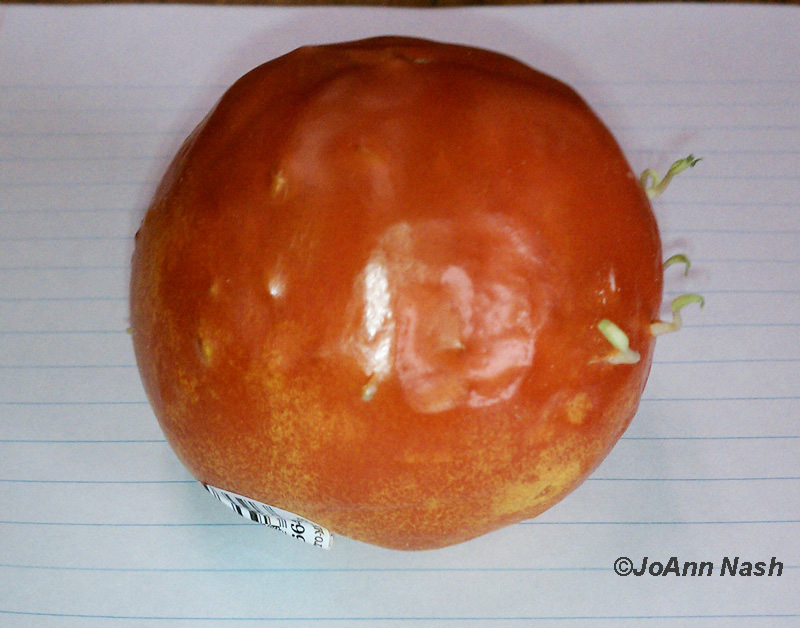January 5, 2012
Wildlife Winter Wonderland
Okay, have you ever seen this before? A tomato sprouting from inside!

JoAnn Nash from from the Round Rock ISD Opportunity Center sent us this picture of colleague Cindy Taylor’s odd tomato. Here’s what happened. Last summer, Cindy’s air conditioner went out and this tomato got a bit warm. This week, Daphne explains, “This situation is called vivipary, Latin for “live birth,” when seeds germinate inside the parent plant. If things are just right, the internal seeds sprout and grow out through the skin.”
JoAnn’s students potted up the “Taylor Mater”, and as it grew into a new plant, fertilized it with fish tank water. They’re keeping it warm over winter, so we’ll keep you posted on their first tomatoes!
Boy, what a difference a few feet can make! This Salvia ‘Anthony Parker’ froze its head off a few weeks ago.

10 feet away, his buddy is still blooming. He can’t be too smug, since winter just began, but these perennials will return from the roots in spring.

Not so the Salvia coccineas. These annuals bid us farewell, unless they left a few seeds behind. But this one hunkered down between some towering woody perennials.

Even one Salvia regla is still flowering. And as predicted earlier, on Christmas day, hoverflies (syrphid flies) feasted on ‘Butterpat’ and ‘Country Girl’ mums. Oxalis, dandelions, Salvia greggiis, and even the snapdragons were targets for bees and butterflies checking out who was serving on New Year’s Day.
Wild asters turned on their “Open” sign.

To celebrate its first birthday, White potato vine (Solanum jasminoides) opened anniversary flowers, with more to come all winter for hungry insects.

The young Copper Canyon daisy (Tagetes lemmonii) keeps on serving, too, framed by an equally new bamboo muhly (Muhlenbergia dumosa). This isn’t typical, but what is in Texas?!

The best thing about my garden is that I’ve planted to feed the wildlife all year round. Garden food is the best, but to supplement the birds, especially over winter, our Christmas gift to them was a platform feeder from Wild Birds Unlimited.

For years, we had a home-brewed version. But we had to replace its bottom window screen a few times a year. It worked great and was inexpensive to make, but when it finally rotted, I decided to glam things up. Actually, any “gift event” is always our excuse to get a new gift for the wildlife!
This time, instead of digging deep to install our pipe stand, we got a $5 pointy metal stake at Home Depot (next to the rebar). I’d used one to hold our bird bath solar panel and really like this thing.

In the moist soil, it took Greg one minute to pound it in. Then we slipped over a piece of conduit that cost less than $4. Since Home Depot even cut it for us, we have more than half for yet another project! I nourished my spray paint fetish and two hours later, we were open for business to a sell-out crowd.

To launch CTG 2012, we start the new year with a resolution to be more mindful of our wildlife. Tom meets with Texas Master Naturalists Lynne and Jim Weber to find out what’s going on with winter wildlife, from migrants to native residents. The Webers also highlight some of the plants to love this winter, including native evergreen ferns.

If there’s one new book you get this year, it simply must be their recently published Nature Watch Austin from Texas A&M Press.

This very hands-on guide takes us month by month about who’s here and what they’re doing, from flora to fauna.

Intelligent and insightful, every chapter reads like an exciting book, rather than a field guide, with “I didn’t know that” at every page turn.

This monthly plant diary includes outstanding photographs of native and adapted plants, peppered with lists to take along to the nursery.

You can also learn more about birds on Travis Audubon’s field trips!
Possumhaw holly (Ilex decidua) is one plant on the Webers’ list for winter berries that sustain residents and migratory birds like Cedar Waxwings. Find out how to grow it as Daphne’s Pick of the Week.

Add water, too, since even a few bowls will give you a 4-star rating! To formalize your outdoor restaurant, Steve Kainer from Hill Country Water Gardens & Nursery demonstrates how easy it is to install a disappearing fountain in one afternoon.

On tour, take a walk with Georgean and Paul Kyle at Chaetura Canyon, the diverse wildlife sanctuary they rescued from invasive, homogeneous roots.
Until next week! Linda
tags:

